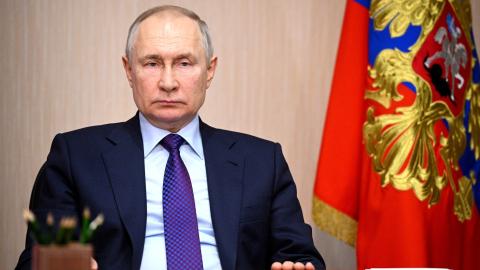As we reach the anniversary of Putin’s invasion of Ukraine on February 24, this is a propitious time to take stock of who has proven to be the big winner in this conflict and of who looks like the loser.
It may come as a shock to many—it’s come as a shock to me—to realize that the biggest winner in this conflict so far is Vladimir Putin, and that the category of losers right now includes the Biden administration and NATO.
It’s important to point out that regarding Putin as the big winner does not discount the incredible bravery of the Ukrainian people or Zelensky’s Churchill-like stature as their president. It does not ignore the terrible losses the Russians themselves have suffered following Putin’s botched strategic plan or the magnificent rallying of the US and the rest of Europe to Ukraine’s aid.
But designating Putin—as opposed to Russia—as the winner so far is a recognition that a year after starting the war, his position as dictator looks more secure than ever. He has managed to hold his own in the fighting in Ukraine, despite losing some 100,000 Russian soldiers (senior US officials estimate the Russian death toll is closer to 200,000) and, after a series of seesaw gains and losses, has ground the war down to a stalemate. He has also turned Ukraine into a demolition site and shattered its economy; it also looks like Crimea is his for good, including the naval base at Sevastopol—his ultimate goal all along.
In addition, any domestic political opposition he might face has been bulldozed out of sight.
As for NATO, it’s perfectly true that the member nations rallied impressively against Putin’s aggression and that the organization grew by two new significant members, Finland and Sweden. Members’ earlier pledges to expand defense spending to 2 percent of GDP may even become reality, although, even after the Russian invasion of Ukraine, only nine of the 29 members meet that threshold, while the US still foots more than half the bill for ensuring the security of the continent.
All the same, there doesn’t seem to be a clear strategy for securing NATO’s boundaries against further Russian aggression, while Putin’s serial threat to use nuclear weapons seems to have worked in preventing NATO from pressing for a decisive Ukraine victory.
In fact, the policy of NATO and the Biden administration this past year seems best characterized as “strategic drift,” a series of ad hoc measures adding new capabilities to the Ukrainian defense—e.g., precision-strike munitions and HIMARS, UAVs and drones, M1 Abrams and Leopard II tanks, and now possibly F-16 fighters—whenever the political opportunity presents itself rather than as part of an overall strategic plan.
Such a plan, for example, might have involved boosting Ukraine’s ability to hit back decisively against the Russian invasion in the opening weeks or months, in ways that might have forced Putin to pull back and rethink his options. Instead, the West’s piecemeal approach has worked in Putin’s favor and allowed him to dig in to achieve the current stalemate—an outcome that serves him domestically as well as to reduce Ukraine to a heap of ruins.
In short, a long war favors Putin, not the West or Ukraine—or the future of Russia. It also favor the other clear winner in the Ukraine conflict—namely, China. The war has steadily weakened Russia as a geopolitical competitor and increased Moscow’s dependence on Beijing for its economic future—including now, it seems, possibly Chinese arms.
Meanwhile, China has had a gratis grand-tier seat from which to watch the future of modern war technology in action, without having to fire a shot or sacrifice a single Chinese soldier or aviator. The crucial role of UAVs and drones, of precision-strike missiles and artillery (e.g., HIMARS), of space assets such as Starlink, of cyber and the weaponizing of social media—it’s all unfolded in ways that allow Beijing to study the results in advance of any Chinese invasion of Taiwan or other military incursion.
Where does this leave us, as we enter the second year of this terrible and destructive war?
First, nothing should undermine the US commitment to support Ukraine or to thwart Putin’s aggression. It just means organizing that commitment better, with a clear picture of where and how Biden and NATO want this conflict to end, instead of making it up as they go along.
Second, it means accepting that a prolonged war only works in Putin’s interest — and certainly not in Ukraine’s. The US and NATO need to press the participants to move toward a negotiated settlement, using the leverage of enabling Ukraine to keep fighting, to bring people to the bargaining table sooner rather than later.
Third, as part of that settlement, NATO and the US will need to agree to lift sanctions against Russia and also extend to Ukrainians a Marshall Plan 2.0 for rebuilding their country. Like the original Marshall Plan, such a large-scale capital investment (General David Petraeus has suggested including financial guarantees by the US and the G-7) could enable Ukraine to arise Phoenix-like as the new economic powerhouse of Europe — the one outcome that would be a humiliating defeat for Putin.
Finally, the US and NATO need to take in the same lessons China will, about how to integrate advanced technologies such as space, UAVs, and precision strike, into our own military posture. It’s an education in modern military science that an administration busy patting itself on the back for its support for Ukraine might be inclined to miss.















